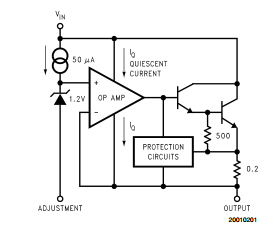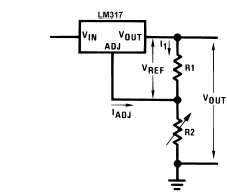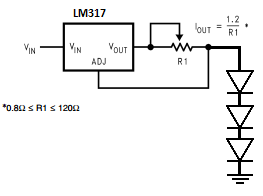SSZTC13 october 2015 LM1086 , LM317-N , LM317A
The LM317-N was the first adjustable voltage regulator, introduced way back in 1975. It’s still widely used in the industry as a constant voltage supply. But did you know that this device can do much more than regulate voltage? Its versatile architecture allows you to use it not just as a voltage regulator but also as a cool, constant-current LED driver.
Wait. Any linear regulator could be used for LED lighting with the addition of a current-limit resistor … what’s new with the LM317-N? Well, it’s actually not what’s new but what’s old that makes the LM317-N click as a simple LED driver.
It’s easy if you understand its architecture. See Figure 1, which shows a functional circuit. An operational amplifier (op amp) connected as a unity-gain buffer drives a power Darlington transistor pair. The op amp and biasing circuitry for the regulator are arranged so that all of the quiescent current is delivered to the regulator output (rather than ground), eliminating the need for a separate ground terminal. Furthermore, all of the circuitry is designed to operate over the regulator’s 2V to 40V input-to-output differential.
 Figure 1 LM317-N Functional
Schematic
Figure 1 LM317-N Functional
SchematicA 1.2V reference voltage appears inserted between the noninverting input of the op amp and the adjustment terminal. You need about 50µA to bias the reference; this current comes out of the adjustment terminal. In operation, the output of the regulator is the voltage of the adjustment terminal plus 1.2V. If the adjustment terminal is grounded, the device acts as a 1.2V regulator. For higher output voltages, a resistor divider R1-R2 is connected from the output to ground, with the adjust pin connected between R1 and R2 as shown in Figure 2. The 1.2V across resistor R1 forces a current flow that causes a drop across R2, resulting in a higher voltage at the adjust pin and thereby setting the output voltage. Equation 1 approximates the output voltage.

Because the architecture ensures a 1.2V differential between the output and the adjust pin, you can use a sense resistor across the two terminals to set a constant current in the circuit. Figure 3 shows the configuration.
 Figure 2 Typical Application Using the
LM317-N
Figure 2 Typical Application Using the
LM317-N Figure 3 Constant-current LED Driver
Using the LM317-N
Figure 3 Constant-current LED Driver
Using the LM317-NYou could connect the output of this to a series of LEDs (with the other terminal connected to ground) to create a very simple LED driver architecture. What are the advantages of this architecture?
- It needs very few components to set up a constant-current topology.
- It is inherently protected from short-circuit and thermal runaway.
- Current regulation is typically 0.01%/V even at low currents, since the quiescent current does not cause an error. This is because the entire quiescent current also flows through the load and not to the ground pin, as in other regulators.
- This high-side sensing architecture allows you to keep the LEDs far away from the control circuitry and improve thermal management of the control circuitry.
- Due to its high-side sensing nature, it is a very cost-effective architecture for automotive systems. The cathode of LED string directly connects to the chassis ground and only one wire runs from the control module to the actual LEDs, thus eliminating a costly and bulky wire in the harness.
The LM317-N has existed for years; almost every semiconductor vendor makes a version. However, we at Texas Instruments took the LM317-N to the next level with the LM317A. The voltage-reference accuracy of the LM317A is 1%. This ensures very tight output-current regulation even with temperature, input and load variations.
For all the reasons I’ve mentioned, the LM317A is a sought-after device for small LED lighting applications, especially when you need a simple linear drive in automotive subsystems. If the dropout of the LM317A (2.5V-3V) is a concern, consider the upgraded LM1086, which takes it down to 1-1.3V and provides more headroom for your lights.